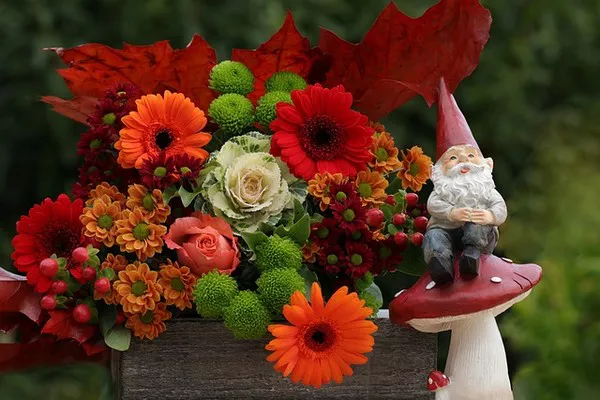Each month of the year is associated with a unique birth flower, adding an extra layer of personal significance to birthdays and special occasions. For those born in November, the Chrysanthemum takes center stage as their birth flower. The Chrysanthemum, often referred to as “mums,” boasts a rich history and symbolism that makes it a fascinating subject of study and admiration. In this article, we will delve into the origins, cultural significance, and characteristics of the November birth flower, shedding light on why it has become an emblem of mystery and transformation.
The History of Chrysanthemums
Chrysanthemums have a storied history that dates back over 2,500 years, making them one of the oldest cultivated flowers known to humanity. Originating in China, their name is derived from the Greek words “chrysos,” meaning gold, and “anthemon,” meaning flower, alluding to their originally golden-colored blooms.
Emperors of ancient China were particularly fond of Chrysanthemums, and they were cultivated in imperial gardens for their beauty and perceived medicinal properties. The Chrysanthemum eventually became so revered that it was incorporated into the Chinese flag, where it symbolized the enduring nature of the nation.
Cultural Significance
Asia:
Chrysanthemums hold a prominent place in Asian cultures. In Japan, the Chrysanthemum is the national flower and is a symbol of the imperial family. The Chrysanthemum Throne is the name given to the position of the Japanese Emperor, reinforcing the flower’s significance in the country’s history and traditions.
In China, the Chrysanthemum is associated with longevity and immortality. It is considered one of the “Four Gentlemen” in traditional Chinese art, alongside the orchid, bamboo, and plum blossom, each representing a season. Chrysanthemums symbolize autumn and are often depicted in artwork during this season.
Europe:
Chrysanthemums were introduced to Europe in the 17th century, and their popularity quickly spread. In Victorian England, the Chrysanthemum became a symbol of friendship and well-wishing, making it a popular gift among friends and loved ones. It was also considered a symbol of truth, as the flower’s name was thought to be derived from the words “chrysos” (gold) and “anthos” (flower).
The United States:
In the United States, Chrysanthemums are commonly associated with fall and are often used in floral arrangements and decorations during the Thanksgiving season. Their vibrant colors and diverse forms make them a versatile choice for autumnal displays.
Characteristics of Chrysanthemums
Chrysanthemums are known for their diverse range of shapes and colors, making them a versatile and captivating flower. Some key characteristics of Chrysanthemums include:
Variety of Colors:
Chrysanthemums come in a wide spectrum of colors, including white, yellow, pink, red, and purple. This variety allows for personalization when choosing a Chrysanthemum bouquet or arrangement.
Unique Petal Arrangements:
Chrysanthemum petals can be arranged in various ways, creating different types of flowers within the same species. For example, the “spoon” petals have elongated tips, while “button” Chrysanthemums have densely packed petals with a button-like appearance.
Diverse Forms:
Chrysanthemums exhibit a range of forms, including single, semi-double, double, and anemone. This diversity provides opportunities for creative floral designs and allows for the expression of various emotions.
Longevity:
Chrysanthemums are known for their long-lasting blooms, making them an excellent choice for cut flower arrangements and displays.
Symbolism of the November Birth Flower
The Chrysanthemum’s symbolism aligns closely with the qualities attributed to those born in November. Let’s explore the symbolism of this captivating flower:
Transformation:
The Chrysanthemum undergoes a remarkable transformation as it transitions from a bud to a fully bloomed flower. This transformation symbolizes personal growth, evolution, and the ability to adapt to change, qualities often associated with individuals born in November.
Mystery:
The Chrysanthemum’s complex and intricate petals create an aura of mystery. Just as November-born individuals are known for their enigmatic and intriguing personalities, the Chrysanthemum’s layers and depths evoke a sense of fascination.
Resilience:
Chrysanthemums are hardy flowers that thrive even in the cooler months. This resilience reflects the determination and strength often associated with November-born individuals, who are known for their ability to weather life’s challenges.
Optimism:
In Victorian England, Chrysanthemums were exchanged as tokens of friendship and well-wishing. This symbolism highlights the optimism and cheerful nature of those born in November, who often bring warmth and positivity to those around them.
Chrysanthemums in Modern Times
In contemporary society, Chrysanthemums continue to be popular for various occasions. Their versatility, long-lasting nature, and rich symbolism make them a favorite choice for flower arrangements and gifts. Here are some ways Chrysanthemums are used in modern times:
Floral Arrangements:
Chrysanthemums are often featured in mixed floral arrangements, adding color, texture, and depth to bouquets. They can be paired with other flowers that share complementary meanings to convey specific messages or sentiments.
Weddings:
Chrysanthemums are a popular choice for wedding decorations and bouquets, symbolizing love and commitment. They can be incorporated into both classic and modern wedding themes, thanks to their diverse range of colors and forms.
Funerals and Remembrance:
In many cultures, Chrysanthemums are used as funeral flowers to honor and remember loved ones who have passed away. Their association with longevity and immortality provides comfort during times of loss.
Home Decor:
Chrysanthemums make for beautiful potted plants and indoor decorations, adding a touch of elegance and warmth to homes. Their long-lasting blooms make them a practical choice for brightening up living spaces.
Conclusion
The Chrysanthemum, the birth flower for November, is a symbol of mystery and transformation that has captivated cultures around the world for millennia. Its rich history, diverse symbolism, and unique characteristics make it a fascinating subject of study and a meaningful choice for personal and cultural celebrations. As you celebrate the November-born individuals in your life or mark your own special day, consider the Chrysanthemum’s enduring beauty and the profound messages it carries. Just as the Chrysanthemum blooms in the face of changing seasons, those born in November embody qualities of resilience, growth, and optimism that inspire us all.


